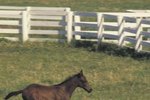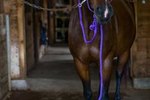There is no singular correct method for teaching a horse to follow you without a halter, but there are many things you should never do, such as force or whip your horse into obeying so that he acts out of fear of punishment rather than trust and submission. A horse in a herd will follow the leader without a lead rope. Therein lies your first clue of how you can get your horse to submit to your leadership without being an ogre: Understand how horses learn and communicate within a herd.
Tips
You can teach your horse to follow you whether or not he already knows how to lead using a halter and lead rope.
Use a Round Pen
Take your horse to a round pen with a long rope, dressage whip or lunge whip inside. A round pen is a controlled and safe environment for a horse to learn. There are no corners for your horse to get "stuck" in, and it's confined enough so that you can stay in control of the training.
Warnings
Round pens with full or half-walls are safest, as it prevents the frightened horse from getting his legs caught in fence or panel rails. Always ensure you have a clear exit path in case the horse becomes dangerous.
Send Your Horse
Instruct your horse to move away from you next to the pen, then cue him to move forward. Your horse may respond quickly with just a raised arm. If he doesn't, ask more forcefully by slapping a rolled rope against your hip, or tossing it behind him. You can do this with a lunge whip, dressage whip or long stick. It is typically not necessary to touch the horse with your sending aid. If he still won't respond, touch him with the lightest possible touch necessary to move him forward.
Keep His Feet Moving
Keep him moving until you notice signs of relaxation. Again, this may take longer in some horses than in others. One of the first signs is licking his lips and making a chewing motion with his mouth. Another sign is if he cocks his ear toward you. With each sign of relaxation, decrease the pressure of your sending aid. For example, if you have been slapping a rolled rope against your hip, simply raise your arm or use your hand. Continue this until you see his neck and head lower, indicating that he is completely relaxed and looks to you as his leader.
Tips
The concept of keeping a horse moving is that you control how and when he moves his feet versus him telling you. It's a way of receiving respect without resorting to force or cruelty.
Allow Your Horse to Move In Beside You
Once you see your horse lick and chew with a lowered head, allow him to move in next to you, then immediately step away and start walking. If he follows you, you have successfully demonstrated to him that you are his trusted leader and he should look to you for guidance. Allow him to follow you in various directions in the round pen.
Tips
Some trainers and horse owners choose to reinforce with treats, while others frown on using treats. There's no right or wrong answer, but a horse who is mouthy or nips at people should not be hand-fed treats.
A Question of Space
Many trainers emphasize a horse respecting a human's personal space, while others de-emphasize that concept. In reality, the horse-human partnership dictates that you and your horse invade the other's personal space. The key is that you, as his leader, dictate when and where that happens. This is no different than the stallion herd leader -- sometimes he allows horses close to him to rest a head on his withers, and other times he gnashes his teeth and "sends them off."
Tips
You should teach your horse to step away from you when you step toward him until you give him a command, such as "whoa," to stand still.
Warnings
You are more likely to be rough and forceful with your horse if you are fearful or angry. If you are afraid, seek expert or professional horse training. If you are becoming impatient or angry, stop what you're doing and continue the next day.
References
Writer Bio
Based in Central Texas, Karen S. Johnson is a marketing professional with more than 30 years' experience and specializes in business and equestrian topics. Her articles have appeared in several trade and business publications such as the Houston Chronicle. Johnson also co-authored a series of communications publications for the U.S. Agency for International Development. She holds a Bachelor of Science in speech from UT-Austin.




